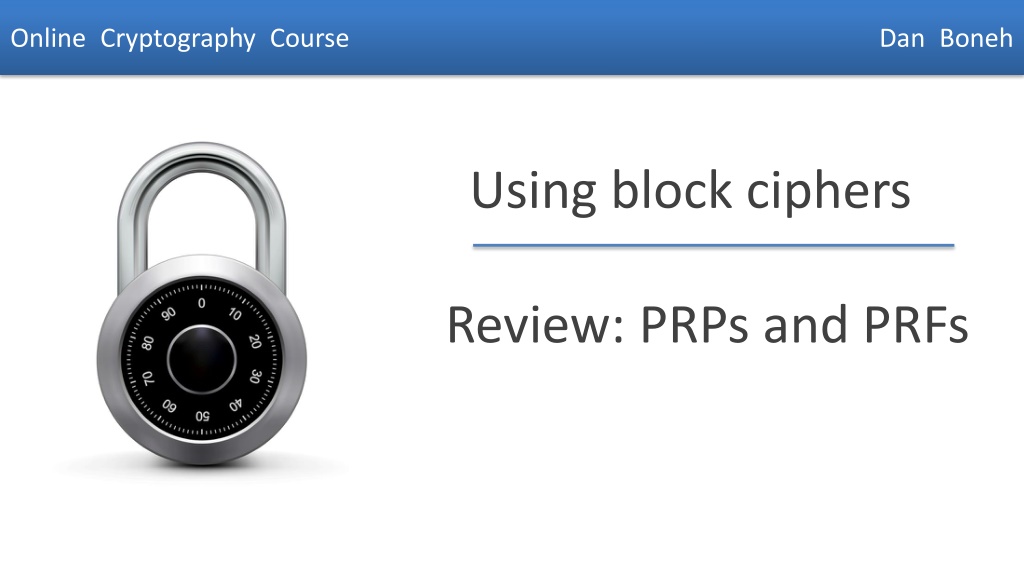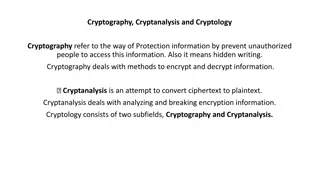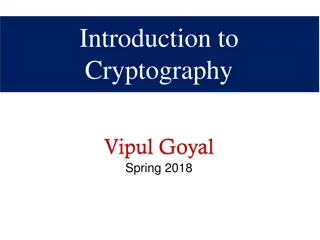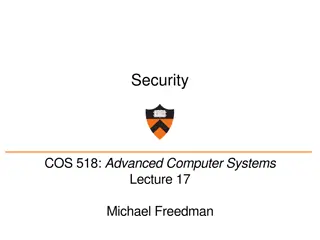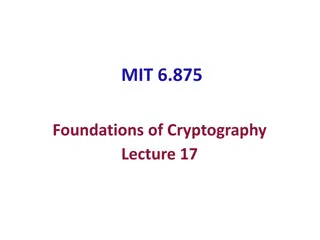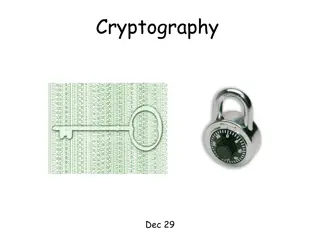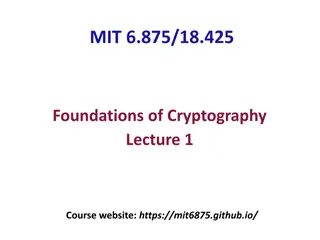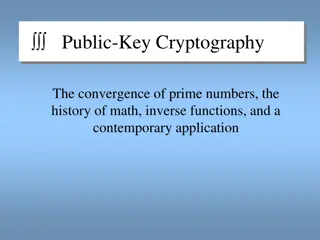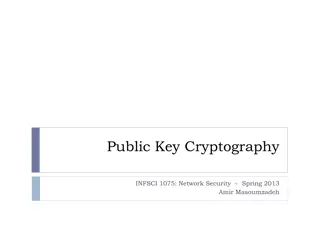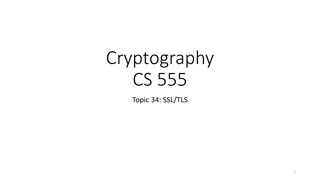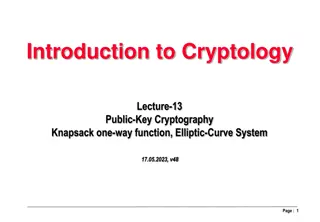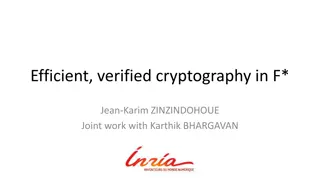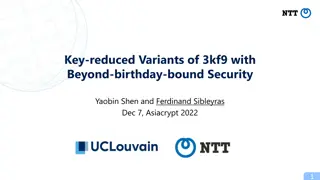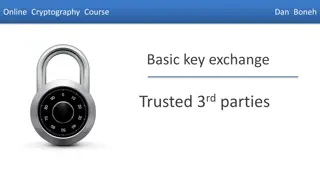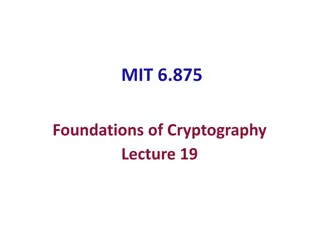Understanding Secure PRFs and PRPs in Cryptography
Dive into the world of secure Pseudo-Random Functions (PRFs) and Pseudo-Random Permutations (PRPs) in cryptography. Learn about the definitions, security criteria, and examples of secure PRFs and PRPs such as 3DES and AES. Explore the concepts of secure block ciphers and key principles behind these cryptographic techniques.
Download Presentation

Please find below an Image/Link to download the presentation.
The content on the website is provided AS IS for your information and personal use only. It may not be sold, licensed, or shared on other websites without obtaining consent from the author. Download presentation by click this link. If you encounter any issues during the download, it is possible that the publisher has removed the file from their server.
E N D
Presentation Transcript
Online Cryptography Course Dan Boneh Using block ciphers Review: PRPs and PRFs Dan Boneh
Block ciphers: crypto work horse n bits n bits E, D PT Block CT Block Key k bits Canonical examples: 1. 3DES: n= 64 bits, k = 168 bits 2. AES: n=128 bits, k = 128, 192, 256 bits Dan Boneh
Abstractly: PRPs and PRFs Pseudo Random Function (PRF) defined over (K,X,Y): F: K X Y such that exists efficient algorithm to evaluate F(k,x) Pseudo Random Permutation (PRP) defined over (K,X): E: K X X such that: 1. Exists efficient deterministic algorithm to evaluate E(k,x) 2. The function E( k, ) is one-to-one 3. Exists efficient inversion algorithm D(k,x) Dan Boneh
Secure PRFs Let F: K X Y be a PRF Funs[X,Y]: the set of all functions from X to Y SF = { F(k, ) s.t. k K } Funs[X,Y] Intuition: a PRF is secure if a random function in Funs[X,Y] is indistinguishable from a random function in SF SF Funs[X,Y] |X| Size |Y| Size |K| Dan Boneh
Secure PRF: definition For b=0,1 define experiment EXP(b) as: b b=0: k K, f F(k, ) b=1: f Funs[X,Y] Chal. Adv. A x1 X , x2 , , xq f , , f(xq) f(x1) , f(x2) b {0,1} EXP(b) Def: F is a secure PRF if for all efficient A: AdvPRF[A,F] := |Pr[EXP(0)=1] Pr[EXP(1)=1] | is negligible. Dan Boneh
Secure PRP (secure block cipher) For b=0,1 define experiment EXP(b) as: b b=0: k K, f E(k, ) b=1: f Perms[X] Chal. Adv. A x1 X , x2, , xq f f(x1) , f(x2), , f(xq) b {0,1} Def: E is a secure PRP if for all efficient A: AdvPRP[A,E] = |Pr[EXP(0)=1] Pr[EXP(1)=1] | is negligible. Dan Boneh
Let X = {0,1}. Perms[X] contains two functions Consider the following PRP: key space K={0,1}, input space X = {0,1}, PRP defined as: Is this a secure PRP? E(k,x) = x k Yes No It depends
Example secure PRPs PRPs believed to be secure: 3DES, AES, AES-128: K X X where K = X = {0,1}128 An example concrete assumption about AES: All 280 time algs. A have AdvPRP[A, AES] < 2-40 Dan Boneh
Consider the 1-bit PRP from the previous question: E(k,x) = x k Is it a secure PRF? Note that Funs[X,X] contains four functions Yes No Attacker A: (1) query f( ) at x=0 and x=1 (2) if f(0) = f(1) output 1 , else 0 AdvPRF[A,E] = |0- | = It depends
PRF Switching Lemma Any secure PRP is also a secure PRF, if |X| is sufficiently large. Lemma: Let E be a PRP over (K,X) Then for any q-query adversary A: | AdvPRF [A,E] AdvPRP[A,E] | < q2 / 2|X| Suppose |X| is large so that q2/ 2|X| is negligible Then AdvPRP [A,E] negligible AdvPRF[A,E] negligible Dan Boneh
Final note Suggestion: don t think about the inner-workings of AES and 3DES. We assume both are secure PRPs and will see how to use them Dan Boneh
End of Segment Dan Boneh
Online Cryptography Course Dan Boneh Using block ciphers Modes of operation: one time key example: encrypted email, new key for every message. Dan Boneh
Using PRPs and PRFs Goal: build secure encryption from a secure PRP (e.g. AES). This segment: one-time keys 1. Adversary s power: Adv sees only one ciphertext (one-time key) 2. Adversary s goal: Learn info about PT from CT (semantic security) Next segment: many-time keys (a.k.a chosen-plaintext security) Dan Boneh
Incorrect use of a PRP Electronic Code Book (ECB): PT: m1 m2 CT: c2 c1 Problem: if m1=m2 then c1=c2 Dan Boneh
In pictures (courtesy B. Preneel) Dan Boneh
Semantic Security (one-time key) m0 , m1 M : |m0| = |m1| c E(k,m0) EXP(0): Chal. k K Adv. A b {0,1} one time key adversary sees only one ciphertext m0 , m1 M : |m0| = |m1| c E(k,m1) Chal. k K Adv. A EXP(1): b {0,1} AdvSS[A,OTP] = | Pr[ EXP(0)=1] Pr[ EXP(1)=1 ] |should be neg. Dan Boneh
ECB is not Semantically Secure ECB is not semantically secure for messages that contain more than one block. b {0,1} Two blocks m0= Hello World m1= Hello Hello Chal. k K Adv. A (c1,c2) E(k, mb) If c1=c2 output 0, else output 1 Then AdvSS [A, ECB] = 1 Dan Boneh
Secure Construction I Deterministic counter mode from a PRF F : EDETCTR (k, m) = m[0] m[1] m[L] F(k,0) F(k,1) F(k,L) c[0] c[1] c[L] Stream cipher built from a PRF (e.g. AES, 3DES) Dan Boneh
Det. counter-mode security Theorem: For any L>0, If F is a secure PRF over (K,X,X) then EDETCTR is sem. sec. cipher over (K,XL,XL). In particular, for any eff. adversary A attacking EDETCTR there exists a n eff. PRF adversary B s.t.: AdvSS[A, EDETCTR] = 2 AdvPRF[B, F] AdvPRF[B, F] is negligible (since F is a secure PRF) Hence, AdvSS[A, EDETCTR] must be negligible. Dan Boneh
Proof m0 , m1 m0 , m1 chal. adv. A chal. adv. A p m0 c m0 k K c f Funs F(k,0) F(k,L) f(0) f(L) b 1 b 1 p p m0 , m1 m0 , m1 chal. chal. adv. A adv. A p m1 m1 c c r {0,1}n k K F(k,0) F(k,L) f(0) f(L) b 1 b 1 Dan Boneh
End of Segment Dan Boneh
Online Cryptography Course Dan Boneh Using block ciphers Security for many-time key Example applications: 1. File systems: Same AES key used to encrypt many files. 2. IPsec: Same AES key used to encrypt many packets. Dan Boneh
Semantic Security for many-time key Key used more than once adv. sees many CTs with same key Adversary s power: chosen-plaintext attack (CPA) Can obtain the encryption of arbitrary messages of his choice (conservative modeling of real life) Adversary s goal: Break sematic security Dan Boneh
Semantic Security for many-time key E = (E,D) a cipher defined over (K,M,C). For b=0,1 define EXP(b) as: b Chal. k K Adv. m1,0 , m1,1 M : |m1,0| = |m1,1| c1 E(k, m1,b) Dan Boneh
Semantic Security for many-time key E = (E,D) a cipher defined over (K,M,C). For b=0,1 define EXP(b) as: b Chal. k K Adv. m2,0 , m2,1 M : |m2,0| = |m2,1| c2 E(k, m2,b) Dan Boneh
Semantic Security for many-time key (CPA security) E = (E,D) a cipher defined over (K,M,C). For b=0,1 define EXP(b) as: for i=1, ,q: b Chal. k K Adv. mi,0 , mi,1 M : |mi,0| = |mi,1| ci E(k, mi,b) b {0,1} if adv. wants c = E(k, m) it queries with mj,0= mj,1=m Def: Eis sem. sec. under CPA if for all efficient A: AdvCPA [A,E] = |Pr[EXP(0)=1] Pr[EXP(1)=1] | is negligible. Dan Boneh
Ciphers insecure under CPA Suppose E(k,m) always outputs same ciphertext for msg m. Then: m0 , m0 M c0 E(k, m0) Chal. k K Adv. m0 , m1 M c E(k, mb) output 0 if c = c0 So what? an attacker can learn that two encrypted files are the same, two encrypted packets are the same, etc. Leads to significant attacks when message space M is small Dan Boneh
Ciphers insecure under CPA Suppose E(k,m) always outputs same ciphertext for msg m. Then: m0 , m0 M c0 E(k, m0) Chal. k K Adv. m0 , m1 M c E(k, mb) output 0 if c = c0 If secret key is to be used multiple times given the same plaintext message twice, encryption must produce different outputs. Dan Boneh
Solution 1: randomized encryption E(k,m) is a randomized algorithm: dec enc m0 m0 m1 m1 encrypting same msg twice gives different ciphertexts (w.h.p) ciphertext must be longer than plaintext Roughly speaking: CT-size = PT-size + # random bits Dan Boneh
Let F: K R M be a secure PRF. For m M define E(k,m) = [ r R, output (r, F(k,r) m)] R Is E semantically secure under CPA? Yes, whenever F is a secure PRF No, there is always a CPA attack on this system Yes, but only if R is large enough so r never repeats (w.h.p) It depends on what F is used
Solution 2: nonce-based Encryption nonce Alice Bob E(k,m,n)=c m, n D(k,c,n)=m c, n E D k k nonce n: a value that changes from msg to msg. (k,n) pair never used more than once method 1: nonce is a counter (e.g. packet counter) used when encryptor keeps state from msg to msg if decryptor has same state, need not send nonce with CT method 2: encryptor chooses a random nonce, n N Dan Boneh
CPA security for nonce-based encryption System should be secure when nonces are chosen adversarially. for i=1, ,q: b Chal. k K Adv. niand mi,0 , mi,1 : |mi,0| = |mi,1| c E(k, mi,b , ni) b {0,1} All nonces {n1, , nq} must be distinct. Def: nonce-based Eis sem. sec. under CPA if for all efficient A: AdvnCPA [A,E] = |Pr[EXP(0)=1] Pr[EXP(1)=1] | is negligible. Dan Boneh
Let F: K R M be a secure PRF. Let r = 0 initially. For m M define E(k,m) = [ r++, output (r, F(k,r) m)] Is E CPA secure nonce-based encryption? Yes, whenever F is a secure PRF No, there is always a nonce-based CPA attack on this system Yes, but only if R is large enough so r never repeats It depends on what F is used
End of Segment Dan Boneh
Online Cryptography Course Dan Boneh Using block ciphers Modes of operation: many time key (CBC) Example applications: 1. File systems: Same AES key used to encrypt many files. 2. IPsec: Same AES key used to encrypt many packets. Dan Boneh
Construction 1: CBC with random IV Let (E,D) be a PRP. ECBC(k,m): choose random IV X and do: IV m[0] m[1] m[2] m[3] E(k, ) E(k, ) E(k, ) E(k, ) IV c[0] c[1] c[2] c[3] ciphertext Dan Boneh
Decryption circuit In symbols: c[0] = E(k, IV m[0] ) m[0] = D(k, c[0]) IV IV c[0] c[1] c[2] c[3] D(k, ) D(k, ) D(k, ) D(k, ) m[0] m[1] m[2] m[3] Dan Boneh
CBC: CPA Analysis CBC Theorem: For any L>0, If E is a secure PRP over (K,X) then ECBC is a sem. sec. under CPA over (K, XL, XL+1). In particular, for a q-query adversary A attacking ECBC there exists a PRP adversary B s.t.: AdvCPA [A, ECBC] 2 AdvPRP[B, E] + 2 q2 L2 / |X| Note: CBC is only secure as long as q2L2 << |X| Dan Boneh
An example AdvCPA [A, ECBC] 2 PRP Adv[B, E] + 2 q2 L2 / |X| q = # messages encrypted with k , L = length of max message Suppose we want AdvCPA [A, ECBC] 1/232 q2 L2 /|X| < 1/ 232 AES: |X| = 2128 q L < 248 So, after 248 AES blocks, must change key 3DES: |X| = 264 q L < 216 Dan Boneh
Warning: an attack on CBC with rand. IV CBC where attacker can predict the IV is not CPA-secure !! Suppose given c ECBC(k,m) can predict IV for next message 0 X c1 [IV1, E(k, 0 IV1)] Chal. k K Adv. predict IV m0=IV IV1 , m1 m0 c [IV, E(k, IV1) ] or c [IV, E(k, m1 IV) ] output 0 if c[1] = c1[1] Bug in SSL/TLS 1.0: IV for record #i is last CT block of record #(i-1) Dan Boneh
Construction 1: nonce-based CBC Cipher block chaining with unique nonce: key = (k,k1) unique nonce means: (key, n) pair is used for only one message nonce m[0] m[1] m[2] m[3] IV E(k, ) E(k, ) E(k, ) E(k, ) E(k1, ) nonce c[0] c[1] c[2] c[3] ciphertext included only if unknown to decryptor Dan Boneh
An example Crypto API (OpenSSL) void AES_cbc_encrypt( const unsigned char *in, unsigned char *out, size_t length, const AES_KEY *key, unsigned char *ivec, AES_ENCRYPT or AES_DECRYPT); user supplies IV When nonce is non random need to encrypt it before use Dan Boneh
A CBC technicality: padding m[3] ll pad IV m[0] m[1] m[2] IV E(k, ) E(k, ) E(k, ) E(k, ) E(k1, ) IV c[0] c[1] c[2] c[3] removed during decryption n n n n TLS: for n>0, n byte pad is if no pad needed, add a dummy block Dan Boneh
End of Segment Dan Boneh
Online Cryptography Course Dan Boneh Using block ciphers Modes of operation: many time key (CTR) Example applications: 1. File systems: Same AES key used to encrypt many files. 2. IPsec: Same AES key used to encrypt many packets. Dan Boneh
Construction 2: rand ctr-mode Let F: K {0,1}n {0,1}n be a secure PRF. E(k,m): choose a random IV {0,1}n and do: msg IV m[0] m[1] m[L] F(k,IV) F(k,IV+1) F(k,IV+L) IV c[0] c[1] ciphertext c[L] note: parallelizable (unlike CBC) Dan Boneh
Construction 2: nonce ctr-mode msg IV m[0] m[1] m[L] F(k,IV) F(k,IV+1) F(k,IV+L) IV c[0] c[1] c[L] ciphertext To ensure F(k,x) is never used more than once, choose IV as: 128 bits IV: nonce counter starts at 0 for every msg 64 bits 64 bits Dan Boneh
rand ctr-mode (rand. IV): CPA analysis Counter-mode Theorem: For any L>0, If F is a secure PRF over (K,X,X) then ECTR is a sem. sec. under CPA over (K,XL,XL+1). In particular, for a q-query adversary A attacking ECTR there exists a PRF adversary B s.t.: AdvCPA[A, ECTR] 2 AdvPRF[B, F] + 2 q2 L / |X| Note: ctr-mode only secure as long as q2L << |X| . Better than CBC ! Dan Boneh
An example AdvCPA [A, ECTR] 2 AdvPRF[B, E] + 2 q2 L / |X| q = # messages encrypted with k , L = length of max message Suppose we want AdvCPA [A, ECTR] 1/232 q2 L /|X| < 1/ 232 AES: |X| = 2128 q L1/2 < 248 So, after 232 CTs each of len 232 , must change key (total of 264 AES blocks) Dan Boneh
